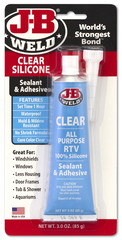Acetoxy-cure silicone adhesives and glass paint
In my last post, we looked at neutral cure silicone adhesives, and why they’re preferred for mounting glass paint projects. The other common kind of silicone adhesive is called acetoxy-cure silicone adhesive, and we do not recommend their use for mounting glass paint projects to various substrates. Let’s take a look at the differences between neutral-cure silicone and acetoxy-cure silicone adhesives, and why they should not be used for mounting glass paint projects.
Why acetoxy-cure silicone adhesives shouldn’t be used
What is an acetoxy-cure silicone adhesive? An acetoxy-cure silicone adhesive is one that contains (and releases) acetic acid as it cures. Like other room-temperature vulcanization (RTV) adhesives, acetoxy-cure silicone adhesives have a short curing time, require no additions to cure, and have some of the same qualities that neutral-cure silicone adhesives do. JB Weld™ and XIAMETER® brand silicone adhesives by Dow Corning are good examples of commonly available acetoxy-cure silicone adhesives.
Acetoxy cure silicone adhesives tend to corrode certain metals, like copper and brass. Copper and brass are used heavily in the areas where people commonly install glass paint projects – kitchens and bathrooms. Older homes with plaster walls may have metal mesh that supports the plaster. It’s possible that the metal in the wall could react with acetoxy silicone adhesives. Because of this, we don’t recommend using acetoxy-cure silicone adhesives. The adhesive itself won’t damage the glass paint application, but it can react badly with important components of the substrate.
Acetoxy-cure silicone adhesives also release an unpleasant odor (smells like vinegar) while they cure. The odor itself is from the acetic acid, and isn’t harmful, but it’s not pleasant, either! Complete curing of a silicone adhesive usually occurs within 72 hours of application, but newly applied silicone can still develop additional adhesive strength as much as a week after application.
Like neutral cure silicone adhesive, acetoxy-cure silicone adhesive is a one-part adhesive. That means you do not need to add compounds to trigger or speed up the curing process. There is a third type of silicone adhesive, which is also considered a “neutral” cure. This third type is referred to as oxime cure. It releases alcohol as a byproduct of the curing process. Oxime-cure adhesive is non-corrosive and is a “one-part” adhesive, but it takes longer to cure than other silicone adhesives do. It’s also not as strong as other silicone adhesives.
Silicone adhesive is good at rejecting water, but water vapor (as in humidity) triggers the curing process for acetoxy-cure silicone adhesives. Humidity will readily penetrate silicone adhesives and can create a condition known as “over-curing.” To avoid over-curing, which can diminish the strength of the adhesive bond, limiting exposure to humidity can be important following the initial cure. Neutral cure silicone adhesive is less affected by humidity, while acetoxy-cure and oxime-cure adhesives will be more negatively affected by humidity. Because kitchens and bathrooms tend to be humid places, neutral-cure silicone adhesives turn out to be the superior choice for glass paint applications.
If you’d like more information about mounting backpainted glass, please check out the rest of our site. If you’d like to purchase Glassprimer™ glass paint, please visit our online store .
Photo Credit: JB Weld.

